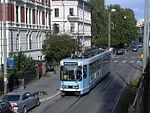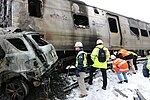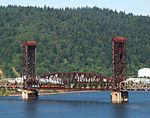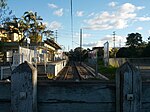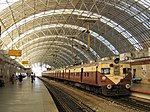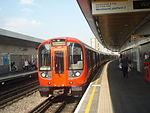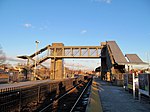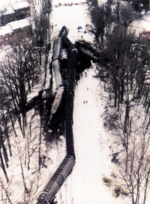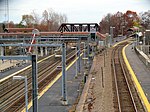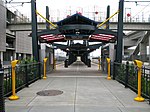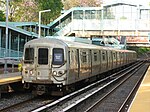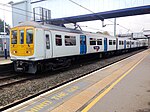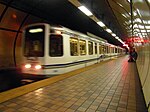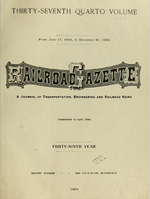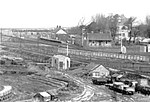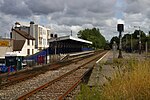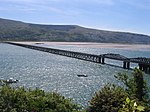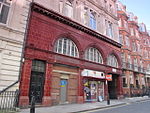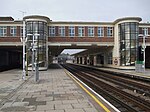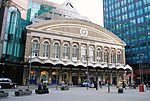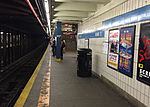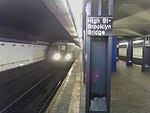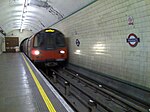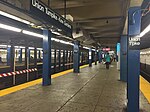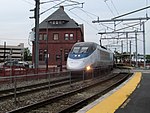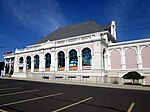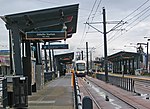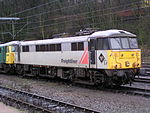This is an archive of article summaries that have appeared in the Selected article section of Portal:Trains in 2016. For past archives, see the complete archive page.
- Week 1
- December 27, 2015 - January 2
The Briskeby Line (Norwegian: Briskebylinjen) is a line of the Oslo Tramway, Norway. It runs from Jernbanetorget westwards through the city center of Oslo before serving the neighborhoods of Briskeby and Uranienborg and terminating at Majorstuen. When Kristiania Elektriske Sporvei opened the line on 3 March 1894, it was the first electric tramway in the Nordic Countries. Originally the line ran through Parkveien instead of Inkognitogata and was mostly single track. The line was doubled in 1898, when the tracks were moved to Inkognitogata. From 1912 the connection to the Ullevål Hageby Line was opened through Hegdehaugsveien. The line was taken over by Oslo Sporveier in 1924. For most of its history the Briskeby Line has been served by Line 1. The transit agency Ruter has proposed that parts of the route be realigned to run through Skovveien.
Recently selected: Breland Station - BR 92220 Evening Star - Oxford Circus tube station
- Week 2
- January 3 - January 9
The Valhalla train crash occurred on the evening of February 3, 2015, when a commuter train on Metro-North Railroad's Harlem Line struck a passenger car at a grade crossing near Valhalla, New York, United States, between the Valhalla and Mount Pleasant stations, killing six people and injuring fifteen others. The crash was the deadliest in Metro-North's history, as well as the deadliest such crash in the United States since the June 2009 Washington Metro train collision had killed eight passengers and injured eighty. The driver of an SUV was caught inside the crossing gate when it descended, wedging itself into the rear of her vehicle, then apparently attempted to rectify the situation by crossing the tracks instead of backing up. She, along with five passengers on the train, died when her vehicle was struck by it. The impact tore loose more than 450 feet (140 m) of third rail. Since grade-crossing accidents typically do not lead to fatalities on board the train, investigators from the National Transportation Safety Board (NTSB) were particularly interested in determining why the fatalities occurred.
Recently selected: Briskeby Line - Breland Station - BR 92220 Evening Star
- Week 3
- January 10 - January 16
The British Rail Class 24 diesel locomotives, also known as the Sulzer Type 2, were built from 1958 to 1961. One hundred and fifty-one of these locomotives were built at Derby, Crewe and Darlington, the first twenty of them as part of the British Rail 1955 Modernisation Plan. This class was used as the basis for the development of the Class 25 locomotives. The final survivor, no. 24081, was withdrawn from Crewe depot in 1980.
Recently selected: Valhalla train crash - Briskeby Line - Breland Station
- Week 4
- January 17 - January 23
The Budd Rail Diesel Car, RDC or Buddliner is a self-propelled diesel multiple unit (DMU) railcar. Between 1949 and 1962, 398 RDCs were built by the Budd Company of Philadelphia, Pennsylvania, United States. The cars were primarily adopted for passenger service in rural areas with low traffic density or in short-haul commuter service, and were less expensive to operate in this context than a traditional diesel locomotive-drawn train with coaches. The cars could be used singly or several coupled together in train sets and controlled from the cab of the front unit. The RDC was one of the few DMU trains to achieve commercial success in North America. RDC trains were an early example of self-contained diesel multiple unit trains, an arrangement now in common use by railways all over the world.
Recently selected: British Rail Class 24 - Valhalla train crash - Briskeby Line
- Week 5
- January 24 - January 30
The Burlington Northern Railroad Bridge 5.1 or BNSF Railway Bridge 5.1, also known as the St. Johns Railroad Bridge or the Willamette River Railroad Bridge, is a through truss railway bridge with a vertical lift that spans the Willamette River in Portland, Oregon, United States. Built by the Spokane, Portland and Seattle Railway (SP&S) and completed in 1908, it was originally a swing-span bridge, and its swing-span section was the longest in the world at the time. However, 81 years later the main span was converted from a swing-type to a vertical-lift type, in order to widen the navigation channel. The lift span is one of the highest and longest in the world. The BNSF Railway owns the bridge, and the 5.1 denotes the distance in miles from Portland's Union Station or from the nearby North Bank Depot (or Hoyt Street Depot), which was the Portland terminus of SP&S passenger service coming via this bridge until 1922. The bridge's two tracks are used by freight trains of BNSF and Union Pacific Railroad and by Amtrak passenger trains. Of 12 bridges across the Willamette River within the city of Portland, it is the sole rail-only bridge and the only bridge not open to the public.
Recently selected: Budd Rail Diesel Car - British Rail Class 24 - Valhalla train crash
- Week 6
- January 31 - February 6
The Carlingford railway line is a minor railway line in Sydney, Australia. Opened in 1888, the line runs north-south between the suburb of Carlingford and the Main Suburban railway line at Clyde. Passenger services on the line form part of the Sydney Trains commuter rail network and are marketed as the T6 Carlingford Line. The railway line's small catchment, low patronage, short platforms and single track for much of its length mean the T6 generally operates as a shuttle service, with passengers changing at Clyde for T1 North Shore, Northern & Western Line services to the Sydney central business district and Parramatta. Most of the line is planned for conversion to light rail as part of the Parramatta Light Rail network.
Recently selected: Burlington Northern Railroad Bridge 5.1 - Budd Rail Diesel Car - British Rail Class 24
- Week 7
- February 7 - February 13
The Central line is a London Underground ("tube") line that runs through central London, from Ealing and Ruislip in the west to Epping, Essex in the north-east. Coloured red on the tube map, the line serves 49 stations, 20 of which are below ground, in 46 miles (74 km). It is the longest tube line. It is also one of only two lines on the London Underground network to cross the Greater London boundary, the other being the Metropolitan. One of London's deep-level tube railways, the trains are smaller than those on British main lines. The line was opened as the Central London Railway in 1900, crossing central London on an east-west axis, as the third deep-level tube line to be built after electric trains made them possible. It was later extended to the western suburb of Ealing. After the Second World War, the line was expanded considerably, taking over steam-hauled outer suburban routes to the east. Many of its stations are of historic interest, from turn-of-the-century Central London Railway buildings in west London to post-war modernist designs on the West Ruislip and Hainault branches, as well as Victorian ECR and GER buildings east of Stratford, from when the line to Epping was a rural branch line. In terms of total passengers, the Central line is the busiest line on the London Underground. The Central line is the busiest and most intensively used railway line in the United Kingdom.
Recently selected: Carlingford railway line - Burlington Northern Railroad Bridge 5.1 - Budd Rail Diesel Car
- Week 8
- February 14 - February 20
The Chennai Mass Rapid Transit System, a state-owned subsidiary of Indian Railways, is a metropolitan elevated railway line operated by Southern Railways. It is the first elevated railway line in India. Although it is segregated from the Chennai Suburban Railway, they both are operated by Southern Railway and are integrated in a wider urban rail network. Built at a cost of ₹ 11,710 million, the line runs within the city limits from Chennai Beach to Velachery, covering a distance of 19.34 km (12.02 mi) with 17 stations, with an average daily ridership of 100,000 commuters a day. Connecting the central business area of old Madras with the IT corridor, the section has a potential capacity of 425,000 passengers a day. In 2011–2012, MRTS registered a revenue of ₹ 198.9 million, registering a 16.25 percent increase, with 134 trains plying across all the 17 stations. The Chennai Metro project is expected to improve transit access in the city and will connect with the Chennai MRTS. To maximise its potential, the MRTS is being extended to St. Thomas Mount, and its operations may be transferred over to the Chennai Metro.
Recently selected: Central line (London Underground) - Carlingford railway line - Burlington Northern Railroad Bridge 5.1
- Week 9
- February 21 - February 27
The Circle line is a London Underground service in a spiralling shape, running from Hammersmith to Edgware Road and then looping once around central London back to Edgware Road. The railway is below ground in the central section and on the loop east of Paddingdon, and, unlike London's deep-level tube railways, the railway tunnels are just below the surface and of similar size to those on British main lines. Coloured yellow on the tube map, the 17-mile (27 km) line serves 36 stations, including most of London's main line railway termini. The first section opened in 1863 when the Metropolitan Railway opened the world's first underground line between Paddington and Farringdon with wooden carriages and steam locomotives. The same year a select committee report recommended an 'inner circle' of railway lines connecting the London railway termini, and the Metropolitan District Railway (commonly known as the District Railway) was formed to build the southern portion of the line. Due to conflict between the two companies it was October 1884 before the inner circle was completed. The line was electrified in 1905, and in July 1933 the two companies were amalgamated into the London Passenger Transport Board. In 1949 the Circle line appeared as a separate line for the first time on the Tube map. In December 2009 the closed loop around the centre of London on the north side of the River Thames was broken at Edgware Road and extended west to become a spiral serving Hammersmith.
Recently selected: Chennai Mass Rapid Transit System - Central line (London Underground) - Carlingford railway line
- Week 10
- February 28 - March 5
Framingham Railroad Station is a historic Boston and Albany Railroad station located in downtown Framingham, Massachusetts. Designed by noted American architect H. H. Richardson, it was one of the last of the railroad stations he designed in the northeastern United States to be built. The station, built in 1884–85, served as a major stop on the B&A Main Line as well as a hub for branch lines to Milford, Mansfield, Fitchburg, and Lowell. After years of deterioration, the station was listed on the National Register of Historic Places in 1975, and restored a decade later. In 2001, MBTA Framingham/Worcester Line and Amtrak operations were shifted to a new set of platforms nearby, which have high-level sections for handicapped-accessible boarding and a footbridge for crossing the tracks. This new Framingham station is among the busiest on the MBTA system, with 41 daily MBTA and 2 Amtrak trains on weekdays. The H. H. Richardson-designed station building remains largely intact and is currently used as a restaurant.
Recently selected: Circle line (London Underground) - Chennai Mass Rapid Transit System - Central line (London Underground)
- Week 11
- March 6 - March 12
The 1996 Maryland train collision occurred on February 16, 1996, when a MARC commuter train collided with Amtrak's Capitol Limited passenger train in Silver Spring, Maryland. An investigation by the National Transportation Safety Board (NTSB) found that the crew of the MARC train had forgotten the indication of an approach signal which they had passed before a station stop, and as a consequence could not slow down in time after encountering a stop signal. The collision killed three crew and eight passengers on the MARC train; a further eleven passengers on the MARC train and fifteen passengers and crew on the Capitol Limited were injured. Total damage was estimated at $7.5 million. The crash led to the creation of comprehensive federal rules for passenger car design, the first in the history of passenger service in the United States, as well as changes to operating rules.
Recently selected: Framingham Railroad Station - Circle line (London Underground) - Chennai Mass Rapid Transit System
- Week 12
- March 13 - March 19
Readville is a passenger rail station located slightly northwest of Wolcott Square in the Readville section of the Hyde Park neighborhood of Boston, Massachusetts. It serves multiple lines on the MBTA (Massachusetts Bay Transportation Authority) Commuter Rail system, with access to the Fairmount Line and Franklin Line on separate platforms. Readville is the terminus of the Fairmount Line, although a small number of rush hour trains continue through the station to and from the Franklin Line. The station has platforms in place on the Northeast Corridor, but they are not used by Providence/Stoughton Line trains except during service disruptions. Passenger service has run to Readville continuously since the Boston and Providence Railroad opened in 1834. Separate stations on two levels were consolidated by the New Haven Railroad around 1898. Until 1958, the railroad had its heavy maintenance facilities located in Readville 5-Yard to the west of the station. The station building burned down in 1983, but the MBTA built replacement platforms and ramps in 1992.
Recently selected: 1996 Maryland train collision - Framingham Railroad Station - Circle line (London Underground)
- Week 13
- March 20 - March 26
Stadium is a light rail station located in Seattle, Washington. It is situated between the SODO and International District/Chinatown stations on the Central Link line, which runs from Seattle–Tacoma International Airport through Downtown Seattle to the University of Washington as part of the Link Light Rail system.. The station consists of an at-grade island platform at the intersection of the SODO Busway and South Royal Brougham Way in the SoDo neighborhood of Seattle, Washington, adjacent to CenturyLink Field and Safeco Field. Stadium Station was proposed in 1998 as part of the segment between the Downtown Seattle and Beacon Hill tunnels and subsequently deferred months later. It was reinstated in 2005 and construction of the station was completed in May 2006, several years before Link light rail service began on July 18, 2009. Stadium Station is also served by several Sound Transit Express and King County Metro buses that stop on the SODO Busway west of the platform, as well as the Seattle Greyhound station east of the platform.
Recently selected: Readville (MBTA station) - 1996 Maryland train collision - Framingham Railroad Station
- Week 14
- March 27 - April 2
The Staten Island Railway (SIR) is the only rapid transit line in the New York City borough of Staten Island. Legally called the Staten Island Rapid Transit Operating Authority (SIRTOA), a unit of the Metropolitan Transportation Authority, it is considered a standard railroad line, but only freight service which runs along the western portion of the North Shore Branch is connected to the national railway system. SIR operates with modified R44 New York City Subway cars, and is run by the New York City Transit Authority, an agency of the Metropolitan Transportation Authority and operator of the New York City Subway. However, there is no direct rail link between the SIR and the subway system proper. The Staten Island Railway provides full-time local service between Saint George and Tottenville along the east side of the borough. The line runs 24 hours a day every day of the year and is one of only six mass-transit rail lines in the United States to do so (the others being the PATCO Speedline, the Red and Blue Lines of the Chicago 'L', the Green Line of the Minneapolis-St. Paul METRO, the PATH lines, and the New York City Subway).
Recently selected: Stadium station (Sound Transit) - Readville (MBTA station) - 1996 Maryland train collision
- Week 15
- April 3 - April 9
The British Rail Class 303 electric multiple units (EMU), also known as "Blue Train" units, were introduced in 1960 for the electrification of the North Clyde and the Cathcart Circle lines in Strathclyde. They were initially classified as AM3 units before the introduction of the TOPS classification system, and were the dominant EMU on the Glasgow suburban railway network for over 25 years before being progressively phased out by newer rolling stock. The final units were withdrawn from service in 2002. The units were later used on the Inverclyde and Argyle lines of the Glasgow suburban railway network as various electrification schemes came to fruition.
Recently selected: Staten Island Railway - Stadium station (Sound Transit) - Readville (MBTA station)
- Week 16
- April 10 - April 16
The British Rail Class 319 is a dual-voltage electric multiple unit train capable of operating on 25 kV AC from overhead wires or 750 V DC from a third rail. They were built in two batches in 1987–88 and 1990 by BREL York for use on north-south cross-London services. The units were primarily used on the then-new Thameslink service operating from Bedford to Brighton and various other destinations south of London. The majority of the fleet remained in use on the Thameslink route after its reshaping and privatisation in 1997. Some of the fleet was also used on various other services operating out of London Victoria, including flagship expresses to Brighton. Since delivery of new rolling stock for Thameslink services commenced in 2015, a number of Class 319 units have been redeployed for use on other operators' services, including in the North West of England.
Recently selected: British Rail Class 303 - Staten Island Railway - Stadium station (Sound Transit)
- Week 17
- April 17 - April 23
Buffalo Metro Rail is the public transit rail system in Buffalo, New York, United States; it is operated by the Niagara Frontier Transportation Authority (NFTA). The system consists of a single, 6.4-mile (10.3 km) long line that runs for most of the length of Main Street (New York State Route 5) in the City of Buffalo, from First Niagara Center in Downtown Buffalo to the south campus of the University at Buffalo in the northeast corner of the city. The first section of the line opened in October 1984; the current system was completed in November 1986.
Recently selected: British Rail Class 319 - British Rail Class 303 - Staten Island Railway
- Week 18
- April 24 - April 30
The R1 is a line of Rodalies de Catalunya's Barcelona commuter rail service, operated by Renfe Operadora. It runs northwards from the Barcelona area to the southern limits of the province of Girona, passing through the coastal Maresme region. Since 2014, some services have been extended further north towards Portbou, near the French border. These services are designated RG1 and are considered part of the Girona commuter rail service. According to 2008 data, the line's annual ridership is 39.6 million, the highest on any line of the Barcelona commuter rail service, with an average weekday ridership of 102,214. R1–RG1 trains primarily run on the Barcelona–Mataró–Maçanet-Massanes railway, the first railway line in the Iberian Peninsula. They use the Meridiana Tunnel in Barcelona, where they share tracks with Rodalies de Catalunya's Barcelona commuter rail service lines R3 and R4, as well as regional rail line R12, calling at Sants, Plaça de Catalunya and Arc de Triomf stations. Together with lines R2, R3, and R4, the R1 (then simply numbered line 1) started services in 1989 as one of the first lines of the Cercanías commuter rail system for Barcelona, known as Rodalies Barcelona. Originally, R1 services had two southern termini, L'Hospitalet de Llobregat and Barcelona–El Prat Airport stations. In the long-term future, it is projected that the R1 will take over the southern section of line R2, creating a major north–south axis that will extend along the coast of the Barcelona metropolitan area.
Recently selected: Buffalo Metro Rail - British Rail Class 319 - British Rail Class 303
- Week 19
- May 1 - May 7
Railroad Gazette was a trade journal first published in April 1856 that focused on railroad, transportation and engineering topics. Master mechanics read and used the publication to share information about railway matters with one-another. An article in the publication documented what was purported to be the first locomotive run in the United States on a railroad, which was stated as performed by the author of the article. It also reported about the Erie Railroad's Rochester Division's electrification and about the opening of the Thebes Bridge. Railroad Gazette editors included Arthur Mellen Wellington and Matthias Nace Forney, and Horace Cleveland was an article contributor. Another publication of the same name Railroad Gazette was established in 1843 in Rogersville, Tennessee. It focused exclusively upon "internal improvement".
Recently selected: R1–RG1 (Rodalies de Catalunya) - Buffalo Metro Rail - British Rail Class 319
- Week 20
- May 8 - May 14
The Second Avenue Subway (officially the IND Second Avenue Line; abbreviated to SAS) is a future New York City Subway line that has been under discussion for almost a century. The line will run primarily under Second Avenue on the East Side of Manhattan. A first phase of this new line is expected to open on December 30, 2016, having been under construction since 2007. It will run between 96th Street and Second Avenue and the existing BMT 63rd Street Line, where it will connect to the rest of the subway system. The full line, when funded, will be built in three additional phases, allowing portions of the line to open before the entire line is completed. When complete, it is projected to serve about 560,000 daily riders. The full proposed Second Avenue line would consist of 16 stations and 8.5 miles (13.7 km) of tunnel, and is expected to cost over $17 billion.
Recently selected: Railroad Gazette - R1–RG1 (Rodalies de Catalunya) - Buffalo Metro Rail
- Week 21
- May 15 - May 21
Winschoten (Dutch pronunciation: [ˈʋɪnsxoːtən] ⓘ; abbreviation: Ws) is an unstaffed railway station in Winschoten in the Netherlands. It is located on the Harlingen–Nieuweschans railway between Scheemda and Bad Nieuweschans in the province of Groningen. The station building, designed by Karel Hendrik van Brederode, was completed in 1865 and expanded in 1904. Train services started on 1 May 1868 and have since been provided by Maatschappij tot Exploitatie van Staatsspoorwegen (1868–1937), Nederlandse Spoorwegen (1938–2000), NoordNed (2000–2005), and Arriva (2005–present). During World War II, 500 Jews were transported from the station via the Westerbork transit camp to Nazi concentration camps, where most of them were killed. The station has three tracks and two platforms. As of 2016[update] there are two local train services with trains every half an hour to and from Groningen, and trains every hour to and from Bad Nieuweschans and Leer (Germany). The station handles 2,500 rail passengers on an average weekday. There is a park and ride area for cars and bicycles, and a bus station with eleven regional services provided by Qbuzz.
Recently selected: Second Avenue Subway - Railroad Gazette - R1–RG1 (Rodalies de Catalunya)
- Week 22
- May 22 - May 28
Avonmouth railway station was the terminus of the Bristol Port Railway and Pier, a self-contained railway which ran along the River Avon in Bristol, England. The station, which opened in 1865, was adjacent to a pier on the River Severn at Avonmouth. It had two platforms and an adjacent hotel, as well as an engine shed and water tank. The station was closed in 1902 as the land was required for the expansion of Avonmouth Docks, although it remained in use for workers' trains until 1903. The hotel continued in operation until 1926, when it too was demolished to make way for the docks. The station site is now in the middle of Avonmouth Docks.
Recently selected: Winschoten railway station - Second Avenue Subway - Railroad Gazette
- Week 23
- May 29 - June 4
Avonmouth railway station is on the Severn Beach Line and serves the district of Avonmouth in Bristol, England. It is 9.0 miles (14.5 km) from Bristol Temple Meads. The station has two platforms, on either side of two running lines. As of 2015[update] it is managed by Great Western Railway, which is the third franchise to be responsible for the station since privatisation in 1997. They provide all train services at the station, mainly a train every forty minutes to Bristol Temple Meads and one every two hours to Severn Beach. The station was opened in 1877 by the Bristol Port Railway and Pier, a railway which ran along the River Avon from Hotwells to a pier at Avonmouth. The station, originally known as Avonmouth Dock, had a single platform, but was rebuilt with two platforms by the Great Western and Midland Railways in 1885 when they began services via Clifton Down. The station was enhanced numerous times in the early part of the twentieth century, and by 1913 employed 72 staff. Facilities included a goods yard, signal box and engine shed. The Severn Beach Line declined over the latter half of the twentieth century, with passenger numbers falling significantly. Goods services at Avonmouth ended in 1966, and all staff were withdrawn in 1967. Services had decreased to 10 per day each direction by 2005, but have since increased to 25 trains per day.
Recently selected: Avonmouth railway station (BPRP) - Winschoten railway station - Second Avenue Subway
- Week 24
- June 5 - June 11
Barmouth Bridge (Welsh: Pont Abermaw), also known as Barmouth Viaduct, is a single-track largely wooden railway viaduct that carries the Cambrian Coast Railway across the River Mawddach estuary on the coast of Cardigan Bay, Wales. It sits between Morfa Mawddach and Barmouth in Gwynedd and caters for rail, foot and cycle traffic. The bridge opened in 1867, and originally included a drawbridge section at its north end for tall ships to pass, though this was later replaced by the current swing bridge section. In 1980, woodworm threatened the safety of the bridge, which needed major repairs to avoid closure. Tolls were collected for foot and cycle traffic until 2013. The bridge is a Grade II* listed structure, and has one of the longest timber viaducts still in regular use in Britain.
Recently selected: Avonmouth railway station - Avonmouth railway station (BPRP) - Winschoten railway station
- Week 25
- June 13 - June 18
The Borders Railway connects the city of Edinburgh with Galashiels and Tweedbank in the Scottish Borders. The railway follows most of the alignment of the northern part of the Waverley Route, a former double-track line in southern Scotland and northern England that ran between Edinburgh and Carlisle. That line was controversially closed in 1969, as part of the Beeching cuts, leaving the Borders region without any access to the National Rail network. Following the closure, a campaign to revive the Waverley Route emerged. Discussion on reopening the northern part of the line came to a head during the early 2000s. Following deliberations in the Scottish Parliament, the Waverley Railway (Scotland) Act 2006 received Royal Assent in June 2006. The project was renamed the "Borders Railway" in August 2008, and building works began in November 2012. Passenger service on the line began on 6 September 2015, whilst an official opening by Queen Elizabeth II took place on 9 September. The railway was rebuilt as a non-electrified, largely single-track line. Several surviving Waverley Route structures, including viaducts and tunnels, were rehabilitated and reused for the reopened railway. Passenger services run half-hourly on weekdays until 20:00, and hourly until 23:54 and on Sundays. The timetable also allows charter train promoters to run special excursion services, and for the weeks following the line opening scheduled steam trains were run.
Recently selected: Barmouth Bridge - Avonmouth railway station - Avonmouth railway station (BPRP)
- Week 26
- June 19 - June 25
The Budd–Michelin rubber-tired rail cars were built by the Budd Company in the United States between 1931 and 1933 using French firm Michelin's "Micheline" rail car design. Michelin built its first rail car in 1929, and by 1932 had built a fleet of nine cars that all featured innovative and distinctive pneumatic tires. In September 1931, an agreement signed between the two companies allowed Budd to use the new rubber rail tires on its shot-welded, stainless-steel carbodies, and at the same time allowed Michelin to expand into the American market. After building two demonstrators, the Budd Company built four production rubber-tired rail cars for American railroads: one for the Reading Company, two for the Pennsylvania Railroad, and the Silver Slipper for the Texas and Pacific Railway. All were plagued by problems, chief among them was their tendency to derail. By 1935, the Silver Slipper had been scrapped, and the Pennsylvania's two cars, the longest surviving of the Budd–Michelin collaborations, met the same fate in 1948. Rubber-tired rail cars achieved greater success in France, and similar rubber-tired subway cars have been adopted in Canada and Mexico as well as on numerous systems in Europe.
Recently selected: Borders Railway - Barmouth Bridge - Avonmouth railway station
- Week 27
- June 26 - July 2
The Buenos Aires Underground (Spanish: Subterráneo de Buenos Aires), locally known as Subte, is a mass transit metro system that serves the metropolitan area of Buenos Aires, Argentina. The first section of this network opened in 1913, making it the first underground railway in Latin America, the Southern Hemisphere and the Spanish-speaking world. The network expanded rapidly during the early decades of the 20th century; by 1944 its main routes were completed. In the late 1990s expansion resumed, and four new lines were planned for the network, with the addition of its newest line occurring in 2007. Two modernisation plans have been presented: City of Buenos Aires law 670, proposing the creation of 3 new lines, F, G and I; and the PETERS plan, wherein 2 lines are created and the I line is postponed for future expansion, plus several other route amendments. As of 2015, Buenos Aires is the only Argentine city with a metro system. The underground network's six lines: A, B, C, D, E, and H, comprise 53.9 kilometers (33.5 mi) of route, serving 85 stations. The network is complemented by the 7.4 km long Premetro line, and the 26 km long Urquiza suburban line, with 17 more stations in total. Over a million passengers use the network, which also provides connections with the city's extensive commuter rail and bus rapid transport networks.
Recently selected: Budd–Michelin rubber-tired rail cars - Borders Railway - Barmouth Bridge
- Week 28
- July 3 - July 9
Clifton Bridge railway station is a former railway station in the Bower Ashton district of Bristol, England, near the River Avon. It was opened in 1867 by the Bristol and Portishead Pier and Railway Company as a single platform stop 3.4 miles (5.5 km) along the line from Bristol to Portishead. It was later taken over by the Great Western Railway and had a second platform added. Passenger services at the station declined following the Second World War, and the Beeching Report recommended the complete closure of the Portishead line. Passenger services at Clifton Bridge ended on 7 September 1964, with goods services following on 5 July 1965, although the line saw occasional traffic until 1981. Most of the station was demolished, leaving some remains of the platforms, a retaining wall and the footbridge. Regular freight trains through the station began to run again in 2002 when Royal Portbury Dock was connected to the rail network. The line is due to be reopened to passenger traffic in 2019 as part of MetroWest, but there are no plans to reopen the station.
Recently selected: Buenos Aires Underground - Budd–Michelin rubber-tired rail cars - Borders Railway
- Week 29
- July 10 - July 16
Down Street, also known as Down Street (Mayfair), is a disused station on the London Underground, located in Mayfair, west London. It was opened in 1907 by the Great Northern, Piccadilly and Brompton Railway. It was latterly served by the Piccadilly line and was situated between Dover Street (now named Green Park) and Hyde Park Corner stations. The station was little used and trains often passed through it without stopping. Its lack of patronage coupled with its proximity to other stations resulted in its closure in 1932. During the Second World War it was used as a bunker by prime minister Winston Churchill and his War Cabinet. The station building survives today and is close to Down Street's junction with Piccadilly. Part of it is now converted to a retail outlet.
Recently selected: Clifton Bridge railway station - Buenos Aires Underground - Budd–Michelin rubber-tired rail cars
- Week 30
- July 17 - July 23
East Finchley is a London Underground station in East Finchley in the London Borough of Barnet, north London. The station is on the High Barnet branch of the Northern line, between Highgate and Finchley Central stations and is in Travelcard Zone 3. The station was opened in 1867 as part of the Great Northern Railway's line between Finsbury Park and Edgware stations. As part of London Underground's only partially completed Northern Heights plan, the station was completely rebuilt with additional tracks in the late 1930s. Northern line trains started serving the station in 1939 and main line passenger services ended in 1941.
Recently selected: Down Street tube station - Clifton Bridge railway station - Buenos Aires Underground
- Week 31
- July 24 - July 30
On 14 November 2015, a TGV train derailed in Eckwersheim, Alsace, France, while performing commissioning trials on the second phase of the LGV Est high-speed rail line, which was scheduled to open for commercial service five months later. The derailment resulted in 11 deaths among those aboard, while the 42 others aboard the train were injured. It was the first fatal derailment in the history of the TGV and the third derailment since the TGV entered commercial service in 1981. The test train was traveling eastbound on the southern track when it entered a curve at 265 km/h (165 mph) causing the rear bogie of the lead power car to derail to the left. The lead power car separated from the rest of the train, and the rear of the lead power car struck the concrete parapet on the abutment to a bridge over the Marne–Rhine Canal. Cars 2–7 derailed and came to rest 80–130 m (260–430 ft) beyond the beginning of the bridge. Cars 8–9 came to rest on the east bank of the canal and the rear power car ended up partially submerged in the canal. According to investigators, late braking, which led to the train entering the curve at excessive speed, was the immediate cause of the accident. SNCF suspended test trials at high speeds until the lessons learned from the investigation were integrated into testing process. The scheduled opening of the second phase of the LGV Est for commercial service was delayed three months, from 3 April 2016 to 3 July 2016.
Recently selected: East Finchley tube station - Down Street tube station - Clifton Bridge railway station
- Week 32
- July 31 - August 6
Elephant & Castle is a London Underground station in the London Borough of Southwark in central London. It is on the Bank branch of the Northern line between Kennington and Borough stations, and is the southern terminus of the Bakerloo line, the next station being Lambeth North. The Northern line station was opened in 1890 by the City and South London Railway (C&SLR) while the Bakerloo line station was opened sixteen years later by the Baker Street and Waterloo Railway (BS&WR). There is out-of-station interchange with the nearby Elephant & Castle National Rail station. The Bakerloo line building remains much as originally constructed and is a typical Leslie Green structure. The Northern line building was designed by Thomas Phillips Figgis, and was rebuilt several times until the current structure opened in 2003. Transport for London (TfL) is currently planning a major upgrade to the station. A Bakerloo line extension south to Camberwell was planned and approved in 1931 but construction never started. Similar proposals have been revived on several occasions; in 2014 TfL ran a consultation on an extension to Hayes and Beckenham Junction, which is still under consideration. In 2015 this station saw just over 19 million passenger boardings and exits, about a 500,000 passenger increase over 2014.
Recently selected: Eckwersheim derailment - East Finchley tube station - Down Street tube station
- Week 33
- August 7 - August 13
Euston is a London Underground station served by the Victoria line and both branches of the Northern line. It directly connects with Euston main line station above it. Euston was constructed as two separate underground stations. Three of the four Northern line platforms date from the station's opening in 1907. The fourth Northern line platform and the two Victoria line platforms were constructed in the 1960s when the station was significantly altered to accommodate the Victoria line. Plans for High Speed 2 and Crossrail 2 both include proposals to modify the station to provide interchanges with the new services.
Recently selected: Elephant & Castle tube station - Eckwersheim derailment - East Finchley tube station
- Week 34
- August 14 - August 20
Everett Station is an Amtrak train station serving the city of Everett, Washington. The station has provided service to the Cascades and Empire Builder routes since its opening in 2002, replacing an earlier station near the Port of Everett. The four-story building also houses social service programs and is the center of a 10-acre (4 ha) complex that includes parking lots and a large bus station used primarily by Community Transit, Everett Transit, and Sound Transit Express. The station has served as the northern terminus of the Sounder North Line since 2003 and Swift Bus Rapid Transit since 2009. It consists of two side platforms, one serving Amtrak and the other serving Sounder commuter trains. Everett Station also functions as a park and ride, with 1,067 short-term parking spaces located in lots around the station after it was expanded by Sound Transit in 2009.
Recently selected: Euston tube station - Elephant & Castle tube station - Eckwersheim derailment
- Week 35
- August 21 - August 27
Fenchurch Street, also known as London Fenchurch Street, is a central London railway terminus in the southeastern corner of the City of London. Trains managed by c2c run on lines built by the London and Blackwall Railway and the London, Tilbury and Southend Railway (LTSR) towards East London and south Essex. The station opened in 1841 to serve trains on the London and Blackwall Railway (L&BR) and was rebuilt in 1854 when the LTSR, a joint venture between the L&BR and the Eastern Counties Railway (ECR) began operating. The ECR also operated services at Fenchurch Street to relieve congestion at its Bishopsgate terminus. In 1862 the Great Eastern Railway was created by amalgamating various East Anglian railway companies (including the ECR) and it shared the station with the LTSR until 1912, when it was bought by the Midland Railway. The station came under ownership of the London & North Eastern Railway (LNER) following the Railways Act 1921, and was shared by LNER and London Midland & Scottish Railway (LMS) services until nationalisation in 1948. The line from the station was electrified in 1961, and controversially closed for seven weeks in 1994. The station is one of the smallest railway termini in London in terms of platforms but one of the most intensively operated. It has no direct interchange with the London Underground. Plans to connect it stalled in the early 1980s because of the lack of progress on the Jubilee Line but it is close to stations, such as Tower Hill.
Recently selected: Everett Station - Euston tube station - Elephant & Castle tube station
- Week 36
- August 28 - September 3
Flushing–Main Street (signed as Main Street on entrances and pillars, and Main St–Flushing on overhead signs) is the northern terminal station on the IRT Flushing Line of the New York City Subway, located at Main Street and Roosevelt Avenue in the Downtown section of Flushing, Queens. It is served by the 7 at all times and the <7> train rush hours in the peak direction. The Flushing–Main Street station was originally built as part of the Dual Contracts between the Interborough Rapid Transit Company (IRT) and the Brooklyn–Manhattan Transit Corporation (BMT). It opened on January 21, 1928, completing the segment of the Flushing Line in Queens. Although plans existed for the line to be extended east of the station, such an extension was never built. The station was renovated in the 1990s. The passenger count in 2015 for the station was 19,082,391, making it the 12th busiest station system-wide, the busiest station in Queens, and the busiest station outside of Manhattan.
Recently selected: Fenchurch Street railway station - Everett Station - Euston tube station
- Week 37
- September 4 - September 10
The General Electric steam turbine locomotives were two steam turbine locomotives built by General Electric (GE) for Union Pacific (UP) in 1938. The two units were streamlined, 90 feet 10 inches (27.69 m) in length, capable of producing 2,500 horsepower (1,900 kW), and reputedly able to attain speeds of 125 miles per hour (201 km/h). Stylistically, they resembled contemporary Electro-Motive Corporation (EMC) diesel designs, especially the UP's M-10003 through M-10006 trainsets. The two locomotives were delivered to UP in April 1939, and they completed test runs and participated in a variety of publicity events for the railroad, including the grand opening of the Los Angeles Union Passenger Terminal, the world premier of Cecil B. DeMille's film Union Pacific, and even an inspection by President Franklin D. Roosevelt. While the locomotives displayed excellent acceleration and an ability to maintain schedules better than conventional steam locomotives, they also demonstrated serious reliability problems and relatively high maintenance costs; they never entered regular revenue service. In June 1939, UP returned the locomotives to GE; by December 1941, the railroad had given up on the project. In 1941, the GE steam turbine locomotives were tested by the New York Central, and they were operated by the Great Northern in 1943 during the World War II "power crunch" (a lack of sufficient locomotives to sustain regular operations) before being retired from service later that year. Ultimately, they were scrapped before the end of World War II.
Recently selected: Flushing–Main Street (IRT Flushing Line) - Fenchurch Street railway station - Everett Station
- Week 38
- September 11 - September 17
Grand Street is a station in Chinatown, Manhattan, on the IND Sixth Avenue Line of the New York City Subway. Opened on November 26, 1967, it was one of two stations added as part of the Chrystie Street Connection (the other being 57th Street–Sixth Avenue, in 1968). The station, located at the intersection of Grand Street and Chrystie Street, is served by the D at all times and the B on weekdays. It is a proposed station on the Second Avenue Subway, whose phase 4 would include new platform(s) connecting to the existing platforms.
Recently selected: GE steam turbine locomotives - Flushing–Main Street (IRT Flushing Line) - Fenchurch Street railway station
- Week 39
- September 18 - September 24
High Street, also labeled as High Street – Brooklyn Bridge, and also referred to as "Brooklyn Bridge Plaza" and "Cranberry Street", is a station on the IND Eighth Avenue Line of the New York City Subway. It is located at Cadman Plaza East near Red Cross Place and the Brooklyn Bridge approach in Brooklyn Heights, Brooklyn. Its name comes from older street names; its original location was at the intersection of High Street and Washington Street. It is served by the A train at all times and the C train at all times except late nights.
Recently selected: Grand Street (IND Sixth Avenue Line) - GE steam turbine locomotives - Flushing–Main Street (IRT Flushing Line)
- Week 40
- September 25 - October 1
Highgate is a London Underground station and former railway station in Archway Road, in the London Borough of Haringey in north London. The station takes its name from nearby Highgate Village. It is on the High Barnet branch of the Northern line, between Archway and East Finchley stations and is in Travelcard Zone 3. The station was originally opened in 1867 as part of the Great Northern Railway's line between Finsbury Park and Edgware stations. As part of their only partially completed Northern Heights plan, the London Underground started serving the station in 1941, using new platforms in tunnels beneath the surface station. The platforms of the surface station remain, but were last used in 1954, and the section of the line through them to Finsbury Park was lifted by 1972. One of the original 1867 station buildings still exists, and is in use as a private house.
Recently selected: High Street (IND Eighth Avenue Line) - Grand Street (IND Sixth Avenue Line) - GE steam turbine locomotives
- Week 41
- October 2 - October 8
The Joseph Scelsi Intermodal Transportation Center (also called the Scelsi ITC) is a transit facility located in downtown Pittsfield, Massachusetts. The $11 million facility is named after Joseph Scelsi, a longtime State Representative who represented Pittsfield. Owned by the Berkshire Regional Transit Authority (BRTA), it is serviced by local BRTA bus services, Amtrak intercity rail service, and Peter Pan intercity bus service. Railroad stations have been located in downtown Pittsfield since the Western Railroad opened in 1841. The original station burned in 1854; after its replacement proved inadequate, a union station was constructed in 1866 to serve the Western plus the Housatonic Railroad and the Pittsfield and North Adams Railroad. A second, larger union station replaced it in 1914. The New Haven Railroad and New York Central Railroad moved to smaller depots in 1960 and 1965, and Union Station was demolished in 1968. Rail service to Pittsfield ended in 1971 but returned in 1975 and moved to a new shelter downtown in 1981. The Scelsi ITC opened in 2004 to combine local and intercity bus and intercity rail operations into one location.
Recently selected: Highgate tube station - High Street (IND Eighth Avenue Line) - Grand Street (IND Sixth Avenue Line)
- Week 42
- October 9 - October 15
The Kawasaki Heavy Industries C151 is a type of train that is one of the four current types of electric multiple unit on the North South and East West Lines of Singapore's Mass Rapid Transit (MRT) system. These are the oldest trains built for the system; they were introduced in 1987 and are still in operation. Sixty-six trainsets consisting of six cars each and a single money trainset consisting of four cars were purchased and are operated by SMRT Trains. These trains were manufactured from 1986 to 1989 in batches by a Japanese consortium consisting of Kawasaki Heavy Industries, Nippon Sharyo, Tokyu Car Corp and Kinki Sharyo following a round of intense competitive bidding by rolling stock manufacturers from around the world. The trains underwent a two-year mid-life interior refurbishment programme by Hyundai Rotem. After major train disruptions on 15 and 17 December 2011, further plans to upgrade its mechanical components to increase its reliability were made. The first trainset to receive this upgrade, which included a replacement traction system, entered service in July 2015.
Recently selected: Joseph Scelsi Intermodal Transportation Center - Highgate tube station - High Street (IND Eighth Avenue Line)
- Week 43
- October 16 - October 22
Kew Gardens–Union Turnpike (signed as Union Turnpike–Kew Gardens on overhead and entrance signs) is an express station on the IND Queens Boulevard Line of the New York City Subway. Located at Union Turnpike and Queens Boulevard on the border of Kew Gardens and Forest Hills, Queens, it is served by the E and F trains at all times. Despite the station's name, Union Turnpike forms the border between Kew Gardens and Forest Hills, and the station straddles that border, with multiple entrances located in each neighborhood.
Recently selected: Kawasaki Heavy Industries C151 - Joseph Scelsi Intermodal Transportation Center - Highgate tube station
- Week 44
- October 23 - October 29
Linx AB was a railway company which operated inter-Scandinavian passenger trains between 2001 and 2004. Established as a joint venture between the Norwegian State Railways (NSB) and the Swedish state-owned SJ, Linx operated the routes from Oslo, Norway, to Stockholm, Sweden, and from Oslo via Gothenburg, Sweden, to Copenhagen, Denmark. Services were provided up to ten times per day. However, slow speeds caused by curvy infrastructure in Norway, combined with competition from low-cost airlines, caused the company to lose money, and eventually grounded operations. The services were taken over by NSB and SJ. The main rolling stock were eleven X2 electric multiple units, although it used Rc-hauled trains on the Gothenburg–Oslo service. The company was based in Gothenburg.
Recently selected: Kew Gardens–Union Turnpike - Kawasaki Heavy Industries C151 - Joseph Scelsi Intermodal Transportation Center
- Week 45
- October 30 - November 5
Lynn (signed as Central Square - Lynn) is a passenger rail station on the MBTA Commuter Rail Newburyport/Rockport Line in downtown Lynn, Massachusetts, located 11.5 route miles from North Station. The station consists of a single center island platform serving the two station tracks on an elevated grade that runs through the downtown area of Lynn. A large parking garage is integrated into the station structure. The present station, built in 1992, is the latest in a series of depots built on approximately the same Central Square site since 1838. A number of other stations have also been located on several different rail lines in Lynn. Lynn is also a major bus transfer point serving 11 MBTA Bus routes in the North Shore region, including routes leading to Salem, Marblehead, Wonderland, and the Liberty Tree Mall as well as downtown Boston.
Recently selected: Linx (railway company) - Kew Gardens–Union Turnpike - Kawasaki Heavy Industries C151
- Week 46
- November 6 - November 12
Montpelier railway station is on the Severn Beach Line and serves the district of Montpelier in Bristol, England. It is 2.85 miles (4.59 km) from Bristol Temple Meads. Its three letter station code is MTP. The station has a single platform, serving trains in both directions. As of 2015[update] it is managed by Great Western Railway, which is the third franchise to be responsible for the station since privatisation in 1997. The station was opened on 1 October 1874 as Montpellier (two 'L's) by the Great Western and Midland Railways as part of the Clifton Extension Railway, designed to connect the port of Avonmouth to the national rail network. In February 1888 the station's name changed to Montpelier (one 'L'). The station had two platforms, with the main structures on the southern platform and smaller waiting rooms on the northern platform. The station building was destroyed by bombing during the Second World War, and replaced with the current building. The Severn Beach Line declined over the latter half of the twentieth century, with passenger numbers falling significantly. Goods services at Montpelier ended in 1965, and all staff were withdrawn in 1967. The line was largely reduced to single track in 1970, with the northern platform abandoned and all trains using the remaining platform. The station building is no longer in railway use. Services had decreased to ten per day each direction by 2005, but have since increased to twenty-four trains per day.
Recently selected: Lynn (MBTA station) - Linx (railway company) - Kew Gardens–Union Turnpike
- Week 47
- November 13 - November 19
The Mountaineer was a passenger train operated by Amtrak between Norfolk, Virginia, and Chicago, Illinois, via Cincinnati, Ohio. It was the first train to use the Norfolk and Western Railway's tracks since the creation of Amtrak in 1971 and followed the route of the Pocahontas, the N&W's last passenger train. Service began in 1975 and ended in 1977. A new train, the Hilltopper, operated over much of the Mountaineer's route but was itself discontinued in 1979.
Recently selected: Montpelier railway station - Lynn (MBTA station) - Linx (railway company)
- Week 48
- November 20 - November 26
New London Union Station is a historic regional rail station located on the Northeast Corridor in New London, Connecticut, United States. It is the primary railroad station in southeastern Connecticut. Union Station is a station stop for most of Amtrak's Northeast Regional trains and a small number of high-speed Acela Express trains. Certain CDOT Shore Line East commuter rail trains also stop at New London, making it the eastern terminus of commuter rail in Connecticut. Union Station serves as the centerpiece of the Regional Intermodal Transit Center serving southeastern Connecticut, with connections to local and intercity buses as well as ferries to Long Island, Fisher's Island, and Block Island. The current Union Station building, built in 1887, is the sixth station to serve New London and one of the oldest stations still in use along the Northeast Corridor. It was the last and largest railroad station designed by famed architect H.H. Richardson.
Recently selected: Mountaineer (train) - Montpelier railway station - Lynn (MBTA station)
- Week 49
- November 27 - December 3
North Philadelphia station is an intercity rail and regional rail station on the Northeast Corridor, located on North Broad Street in the North Philadelphia neighborhood of Philadelphia, Pennsylvania, United States. The Southeastern Pennsylvania Transportation Authority's (SEPTA) Regional Rail Trenton Line and Chestnut Hill West Line account for most of the station's service; five Amtrak trains also stop each weekday. The station opened in the 1870s and was known as New York Junction and Germantown Junction. A new station, which ushered in the Beaux-Arts style for large train stations, was built from 1896 to 1901. After a 1912–1915 enlargement, it was renamed as North Philadelphia. Despite several other renovations, its use declined in the mid and late 20th century; in 1991, Amtrak constructed a smaller replacement station across the tracks. The building was renovated once more in 1999 and is now used as commercial space. It was added to the National Register of Historic Places the same year.
Recently selected: New London Union Station - Mountaineer (train) - Montpelier railway station
- Week 50
- December 4 - December 10
Othello is a light rail station located in Seattle, Washington. It is situated between the Rainier Beach and Columbia City stations on the Central Link line, which runs from Seattle–Tacoma International Airport to Downtown Seattle and the University of Washington as part of the Link light rail system. The station consists of two at-grade side platforms between South Othello Street and South Myrtle Street in the median of Martin Luther King Jr. Way South in the NewHolly neighborhood, part of Seattle's Rainier Valley. The station opened on July 18, 2009. Trains serve the station 20 hours a day every day; the headway between trains is 6 minutes during peak periods, with less frequent service at other times. Othello station is also served by three King County Metro bus routes that connect it to Beacon Hill, Downtown Seattle, Mount Baker, Renton and West Seattle.
Recently selected: North Philadelphia station - New London Union Station - Mountaineer (train)
- Week 51
- December 11 - December 17
The British Rail Class 86 was the standard electric locomotive built during the 1960s. One hundred of these locomotives were built from 1965 to 1966 by either English Electric at Vulcan Foundry, Newton-le-Willows, or British Rail (BR) at their Doncaster works. The class was built to haul trains on the then newly electrified West Coast Main Line, from London Euston, to Birmingham, Crewe, Manchester Piccadilly, Liverpool and later Preston and Glasgow. They helped to replace steam locomotives, which were finally withdrawn by BR in 1968. Under the earlier BR classification system, the type was given the designation AL6 (meaning the 6th design of AC Locomotive), and locomotives were numbered E3101-E3200. In 1968, this was changed to Class 86, when BR introduced the TOPS classification system.
Recently selected: Othello station - North Philadelphia station - New London Union Station
- Week 52
- December 18 - December 24
Patchway railway station (station code PWY) is on the South Wales Main Line, 6 miles (10 km) from Bristol Temple Meads, serving the Bristol suburbs of Patchway and Stoke Gifford in South Gloucestershire, England. As of 2015[update] it is managed by Great Western Railway, which is the third franchise to be responsible for the station since privatisation in 1997. They provide all train services at the station, mainly a train every hour in each direction between Cardiff Central and Taunton. The station was opened by the Bristol and South Wales Union Railway in 1863 with a single platform, 0.5 miles (0.8 km) west of the current location, but was resited in 1885 when the line was widened to double track. The station once had large buildings and a goods yard which were demolished in the late 20th century, with small brick shelters built in their place. The line through Patchway is due to be electrified as part of the 21st-century modernisation of the Great Western Main Line.
Recently selected: British Rail Class 86 - Othello station - North Philadelphia station
- Week 53
- December 25 - December 31
Pill railway station was a railway station on the Portishead Branch Line, 7.8 miles (12.6 km) west of Bristol Temple Meads, serving the village of Pill in North Somerset, England. The station was opened by the Bristol and Portishead Pier and Railway Company on 18 April 1867. It had two platforms, on either side of a passing loop, with a goods yard and signal box later additions. Services increased until the 1930s, at which point a half-hourly service operated. However the Portishead Branch was recommended for closure by the Beeching report, and the station was closed on 7 September 1964, although the line saw freight traffic until 1981. Regular freight trains through the station began to run again in 2002 when Royal Portbury Dock was connected to the rail network. The station is due to be reopened to passenger traffic in 2019 as part of MetroWest, a scheme to increase rail services in the Bristol area. The new station will have a single platform, an accessible footbridge and a car park, with trains running between Portishead and Bristol.
Recently selected: Patchway railway station - British Rail Class 86 - Othello station
